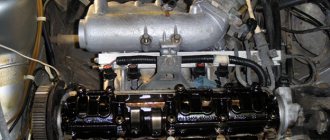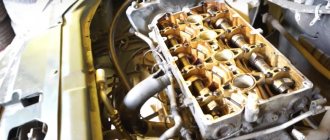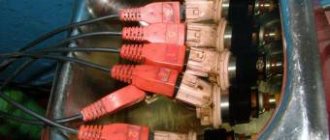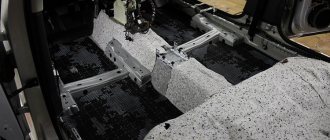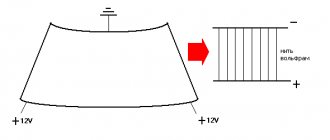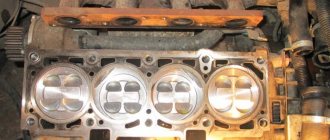If owners of classics quite often complain about malfunctions of the interior heater, then the VAZ-2114 stove in this regard works quite stably, coping “well” with its immediate responsibilities. If the interior is in good condition, even in severe frost, the stove will be able to provide a comfortable temperature, and ice on the windshield will be removed within a few minutes.
How to replace the stove in a VAZ-2114.
The device of the VAZ-2114 stove
Before we deal with the operation of replacing the VAZ-2114 heater, let’s consider its structure and operating principle. The interior/windshield heater is located in the instrument panel (dashboard) area under the center console. All elements of the device, with the exception of deflectors and heater control handles, are hidden inside the panel. Main components of the stove:
- radiator;
- casing;
- inlet/outlet pipes;
- tap;
- electric motor with impeller;
- main damper;
- driver/front passenger foot air damper;
- heated windshield flap;
- control module (operating mode switch handle, damper control knobs, resistor).
The operating principle of the heater is based on the use of heat exchange processes between the coolant and the atmospheric air entering the car interior. The main element of the heating device is a radiator with a system of tubes through which coolant circulates. When cooling the power unit, the liquid heats up, which allows the tubes to be equipped with special lamellas to release heat, heating the air.
An electric fan is built into the radiator, the main purpose of which is to pump air into the system. The intensity of the air flow entering the car interior can be adjusted using a switch located on the central panel of the VAZ-2114. It changes the resistance of the built-in resistor, thereby allowing you to reduce or increase the fan speed.
The air flow, passing between the lamellas of the radiator tubes, is heated in the body of the VAZ-2114 stove and enters the cabin through the air ducts. The central damper allows you to regulate the flow of air into the cabin (when the damper is completely closed, the air supply is blocked). Two other flaps allow you to change the direction of air flow when blowing the windshield and feet. Although the stove is an integral part of the car's heating system, it can be completely turned off by turning off a special tap.
Cost of work to replace the radiator of the Kalina and Priora stoves
| Name of works | Kalina | Priora |
| Replacing the interior radiator | from 5000 ₽ | from 4000 ₽ |
| Replacement el. interior heater motor | from 4000 ₽ | from 2000 ₽ |
There is a discount program for regular customers!
The above prices are only for basic work. We are always happy to answer your questions by phone or in person to help solve your problem and accurately formulate the cost of work specifically for your car.
Find out the cost of work for your car
+7 (4812) 24-30-35+7 (920) 661-01-01
call me back
Smolensk, st. Popova, 100 b | Mon – Fri 9:00 – 20:00 | Sat - Sun 9:00 - 18:00 | nonstop
Possible malfunctions of the VAZ-2114 stove
Despite the fairly simple design of the heater, some of its elements may fail over time. At the same time, the probability of failure of the heating system as a whole is quite small. The most common stove failures include:
- problems with the radiator;
- faucet leak;
- wear of pipes;
- resistor failure;
- switch malfunctions.
Let's look at each fault block in more detail.
Why is it better to replace your VAZ (Lada) heater radiator here?
The authorized Motul Expert technical center in Smolensk provides its customers with exceptionally top-class service. For full maintenance of VAZ (Lada) , we have:
- 23 posts;
- 18 lifts;
- original spare parts – always available for the most common models of foreign and domestic manufacturers;
- Assorted branded Motul oils.
We serve individuals, individual entrepreneurs and large enterprises. Cooperating with us is always beneficial thanks to:
- guarantee provided for all work;
- an individual approach when discussing the terms and conditions of payment;
- expanded discount program for regular customers.
Heater radiator failures
The most common causes of radiator failure are:
- depressurization of the device;
- clogged tubes.
When clogged, the internal radiator tubes become covered with deposits, narrowing their clearance and impairing the circulation of coolant. Clogging most often occurs as a result of using poor-quality coolant. The advanced age of the car also leads to the appearance of this problem, as does the entry of dust, dirt, water, and friction products of the power unit into the heating system. Due to a significant decrease in the circulation rate, normal heat exchange is disrupted, and the antifreeze simply does not have time to cool, which leads to engine overheating.
The appearance of a leak in the radiator is a consequence of mechanical damage, corrosion processes and drying out of the material from which the radiator tubes are made. In this case, a decrease in the volume of antifreeze leads to an increase in its temperature and a deterioration in engine cooling, as evidenced by the readings of the temperature sensor.
Stove tap leaking
This malfunction occurs as a result of the heater housing drying out or due to souring of the shut-off device. The last reason is usually a consequence of the car being idle for a long time. In order not to damage the faucet or break the control cable, in such cases it should be opened very carefully, without using excessive force.
When the stove dries out, it is often not possible to diagnose the malfunction in time, since the leak may be minimal. But over time, the coolant leaking from the stove will certainly make itself felt. The first obvious sign of this malfunction is the appearance of a puddle on the floor of the car in the area of the passenger seat closer to the center panel. A driver or passengers with a good sense of smell can sense a characteristic odor before a puddle appears, which will only increase.
Another nuisance when the heater tap leaks is the formation of a thin oil deposit on the windshield, which appears as a result of evaporation of the coolant. At night, or when the sun shines directly into the driver's eyes, this can cause problems with the quality of vision, making it difficult to make the right decisions in a timely manner when the traffic situation changes. Such stains are difficult to remove, and if the leak is not eliminated, an oil film will form again and again. The operation to replace the VAZ-2114 tap will require partial removal of the stove.
Replacing the heater radiator on a Priora with air conditioning
After some time, the manufacturer began to equip its cars with air conditioning (climate control), for example, HALLA or Panasonic (article: 21703-8101012). The design of the new Priora heater from a maintenance point of view turned out to be much more convenient. Now, to replace the stove, you do not need to dismantle the frill, windshield wipers, heater or vacuum brake booster.
It is only necessary to: remove the sound insulation of the engine shield, remove the engine air filter hose and the seal in the area of the heater radiator hoses. All! Drain the antifreeze and remove the radiator towards you, towards the engine.
Video instructions are attached:
Thus, replacing the radiator of a Priora stove depends not only on the type of heater, but also on the chosen method of replacing it. How did you remove the heater radiator on your car? Which method suits you best? Let us remind you that solutions to other problems with the stove can be found in this article.
Keywords: Lada Priora stove | air conditioner Lada Priora
1 0 0 0 0 0
Share on social networks:
Wear of pipes
Coolant may leak from the heating system through the inlet/outlet pipes. This result is usually caused by their wear under the influence of aggressive substances that are components of the liquid, combined with high temperature. The appearance of leaks in the pipes can also be caused by excessive efforts when tightening the clamps during their installation (for example, after replacing leaky old pipes).
The heating system of the VAZ-2114 car includes 4 pipes, half of which are located in the engine compartment, ensuring the passage of antifreeze between the power unit and the heater, and the other two are located in the cabin, ensuring coolant circulation between the radiator and the heater tap. Liquid leakage can occur in two different scenarios. The first involves antifreeze leaking out into the area where the power unit is protected; with the second option, it will flow into the cabin. Signs of a leak in the pipes:
- decreasing coolant level in the expansion tank;
- the appearance of a persistent unpleasant odor in the cabin;
- presence of smudges in the passenger compartment or under the engine protection.
Resistor fault
As noted above, the resistor is designed to change the level of resistance of the current supplied from the generator to the heating system fan. In the VAZ-2114, using a switch, you can ensure the fan operates in three modes. In the extreme position, the fan is powered by a voltage equal to the nominal voltage of the vehicle's on-board network, providing maximum power output. In the intermediate position of the switch, the level of the supplied voltage is reduced due to one of the two resistor windings, the resistance of which increases by 0.20 Ohms. In the third mode, the second winding also comes into operation, due to which the total resistance of the resistor increases by 0.80 Ohms, reducing the fan rotation speed to a minimum.
If the windings burn out, regardless of the switch position, the fan operates only at full power. The inability to switch fan operating modes is evidence of a resistor malfunction.
Types of repairs
Depending on what fuel the VAZ-2114 engine runs on, major overhauls are distinguished:
- A unit operating on gasoline.
- Diesel engine.
From the one who carries out the work, major repairs happen:
- Independent.
- Auto service specialist.
- A private craftsman who works in his garage.
Major repairs are identified according to urgency:
- Urgent.
- Not urgent.
Repair of the VAZ-2114 stove
Many novice car enthusiasts blame the stove when their heating system breaks down. Indeed, replacing it in most cases solves all problems. However, the feasibility of such a decision is highly questionable for a number of reasons. First of all, due to financial reasons: the cost of a new stove for the VAZ-2114 (without pipes and faucet) will cost a tidy sum - about 4,000 - 5,000 rubles. The second important point is the complexity of the replacement operation itself, since installation/dismantling of the instrument panel will be required. This may require a whole day of work, and you cannot do it without an assistant. It is much easier to find out the exact cause of the stove’s inoperability and eliminate only that.
What does the price depend on?
Motorists who need engine overhaul of a VAZ-2114 are faced with different prices for such a service. The cost depends on the influence of factors:
- Engine capacity.
- The prestige of the service company, its pricing policy.
- Urgency.
- Scope of work.
- Difficulty of repair.
- The need for a specialist to visit.
- Cost of spare parts.
- Equipment used.
- Automotive technician qualification level.
The more work is required to restore the engine of a VAZ-2114 car, the more expensive the service of a specialist will cost. You will have to pay extra for urgency and a specialist visit.
Radiator repair
It is quite possible to clean the radiator pipe system from deposits and scale. To do this, you can use the same cleaning products that are usually used in everyday life (“Silit”, “Mole”, Comet). However, any chemically active compositions will do, including Coca-Cola (you’ve probably repeatedly seen materials devoted to this drink regarding its chemical properties). As practice shows, better results can be achieved by working with the radiator removed, but this is not critical. Completely satisfactory cleaning can be performed without dismantling the radiator. The flushing scheme is very simple: the antifreeze is drained, all pipes are disconnected, after which a cleaning agent is poured into the filler neck. Then the engine starts, which, with the heater on, should idle for about 40 - 120 minutes.
After cleaning, the radiator is thoroughly washed, for which you can use running water from a tap connected through a suitable hose. The final stage is to dry the radiator with compressed air (if a compressor is available) or naturally, which will take at least a day. The presence of a leak is a much more serious problem. It can be eliminated by soldering. At the same time, finding a leak in itself can be a time-consuming task, which is unlikely to be accomplished without removing the radiator.
Soldering is also difficult, since the radiator tubes are made of aluminum. For such work you need a very powerful soldering iron, supplemented with special solders and flux. The quality of soldering also depends on the skills of the worker performing such repairs: if they are small, there is a high probability that over time the leak will be restored in the same place. Therefore, it makes sense to replace the radiator with a new one, the cost of which varies within a thousand rubles.
What to choose?
Today, for the VAZ 2114, two options for radiators are offered, which differ in the material of manufacture. This can be a copper or aluminum unit.
To understand which one is better, let's conduct a comparative analysis.
| Radiator type | Advantages | Flaws | Price |
| Aluminum | — The number of side ribs exceeds those of the competitor — The air flow channels are wider, which reduces the risk of crashing and increases the efficiency of heat transfer at idle speed | — Rapid heating is accompanied by equally rapid cooling — If a leak is detected, repair is impossible, only replacement | from 1000 rubles |
| Copper | — It takes a long time to heat up, but at the same time it takes a very long time to cool down; — If a leak occurs, repairs can be made by soldering the holes | — In terms of the number of ribs it is inferior to its aluminum competitor; — The channels are narrow and small, they clog quickly, which reduces heating; — Repairs have to be carried out more often due to clogged channels; — Minimally heats at idle; — It is difficult to find a high-quality heater, since almost always, in addition to copper, there are impurities that reduce the efficiency of the radiator | from 1700 rubles |
From this we can conclude that aluminum ones are more popular than copper ones. But this popularity is due to the availability and opportunity to purchase a high-quality aluminum product.
Aluminum device
Which of these you choose is up to you to decide. Although copper is more expensive, it can be repaired, while if an aluminum device fails, you will certainly have to buy a new unit.
Copper analogue
Replacing the radiator without removing the dashboard
If you believe the VAZ-2114 manual, then any radiator repair is impossible without removing the panel. In reality, only partial dismantling of the panel is required. A set of tools required for this operation:
- Phillips head screwdriver;
- wrenches (wrench or socket) for 7/10/13;
- rags;
- containers with a volume of 5 liters or more for draining antifreeze from the VAZ-2114 cooling system;
- a small but wide container for draining antifreeze from the stove radiator;
- high density polyethylene film.
Instructions on how to remove the stove on a VAZ-2114:
- We install the car on an overpass or other place with good access to the bottom of the engine compartment.
- Remove the negative terminal from the battery.
- Remove the motor protection, which is held in place with 10mm bolts.
- Drain the coolant by unscrewing the bolt plug (after placing a prepared container under it) with a 13 key.
- We unscrew the cap of the expansion tank, which will speed up the flow of antifreeze from the cooling system (by equalizing the partial pressure).
- We wait until the coolant stops dripping and screw the plug into place.
- Completely close the stove faucet (extreme left position of the control lever).
- Move the right (passenger) seat to the rearmost position and lower the backrest all the way.
- Using a screwdriver, unscrew the self-tapping screw located in the center of the panel and closed with a plug.
- Unscrew 4 screws in sequence that secure the left panel cover (access from the passenger seat).
- We carry out the same operations with the instrument panel.
- We unscrew the 6 screws that secure the plastic casing to the steering column (three each on top and bottom).
- Disconnect the radio/cigarette lighter terminals.
- Carefully remove the covers on the heater damper control levers.
- We dismantle the upper part of the console (attached with two self-tapping screws);
- Unscrew the two screws that secure the diagnostic connector.
- We dismantle the central console of the panel, having first disconnected all the connectors (it is advisable to photograph them before removal, so as not to confuse anything during the reverse procedure).
- Unscrew the two screws that secure the panel to the body frame.
- Unscrew the four screws (two upper and two lower) of the side fastening.
- We unscrew the screws that secure the panel to the base.
- Having gained access to the ECU, remove it by disconnecting all interfering connectors.
- On the right side it becomes possible to lift the panel and pull it back a little. We do this by fixing it in this position.
- We gain access to the radiator, spread a film under it and place a wide but shallow container to drain the antifreeze.
- Using a 7mm wrench or a screwdriver, remove the clamps that hold the pipes. We unscrew it gradually, not allowing the coolant to drain under high pressure.
- We wait until all the antifreeze flows out of the radiator and pipes.
- Unscrew the screws that hold the radiator in place and remove it.
- We install a new radiator and perform all operations in reverse order.
As you can see, you will have to tinker a lot, the main thing is to adhere to the specified sequence of disassembly and assembly.
Replacing the faucet
To replace the faulty faucet of the VAZ-2114 stove, we will need 10/13 wrenches (socket ones will work much more conveniently), rags, a Phillips-head screwdriver, and a container for draining the coolant. Dismantling algorithm:
- we drive the car onto an overpass/inspection hole, place a prepared container with a capacity of about 5 liters under the drain hole, unscrew the plug and wait until all the antifreeze is drained;
- We look in the engine compartment for the pipes connecting the power unit to the tap, use a screwdriver to loosen the fastenings in the form of clamps, and remove the pipes;
- go to the interior, unscrew the screws that secure the left panel cover;
- on the right side under the panel we find the heater tap, to which the pipes from the engine compartment are connected, put a rag under them and use a screwdriver to remove both pipes;
- go back to the engine compartment, find the studs on which the faucet is attached to the car body, unscrew the bolts with a 10mm wrench;
- now nothing is holding the crane, we go into the interior and pull it out, disconnecting the drive fastening cable;
- We attach the cable to the new tap, install it in its original place and reassemble it in the reverse order.
https://www.youtube.com/watch?v=ZFJrh_oKTpQ
Work order
Remember that the price of replacing the VAZ 2114 heater radiator depends only on you! First of all, treat the purchase of a new radiator with full responsibility.
ADVICE.
Buy a quality heating radiator! Don't save money. Moreover, the difference in price will be no more than 200–300 rubles.
Replacing the VAZ 2114 heater radiator begins with preparing the tool. Knowledgeable people advise lubricating your hands with cream or wearing gloves. There will be fewer cuts. After completing the work, it is easier to clean your hands of dirt.
To drain the coolant (coolant), wrap the hose into the hole in the plug of the power unit, and the antifreeze will go into a container that must first be placed.
We insert the hose from the mixer directly into the engine drain hole. At the second stage, we will remove the glove compartment and the sides of the panel. It is necessary to unscrew all the bolts and screws that come into view.
The glove compartment you will remove consists of 3 parts. If the process doesn't go as expected, you may have forgotten or missed the two bolt-on mountings on the front panel. They hold the structure, pressing it to the floor. Look at the photo. You can see that the mount is located at the bottom of the ECU (electronic control unit).
We unscrew the fastenings holding the cables alternately on the left and right sides.
ATTENTION!
This operation takes a lot of time and is the most labor-intensive!
Now you can take a break, look around and check that all retaining elements have been removed. Pay attention to the two screws located closer to the front passenger door. Another one in the upper right part of the panel. It is hidden behind a plug.
A video about replacing the radiator of a VAZ 2114 stove can be viewed here.
ADVICE.
Gently pull the panel towards you, do not overdo it! The structure must go away.
If the process is going slowly, you need to make sure that all fasteners are removed and unscrewed. As a safe option, you can remove the adjusting tips from the stove and damper. For the convenience of pressing the structure, you can use any objects. Simple and reliable, as you can see.
Before unscrewing the two clamps attached to the radiator, do not forget to place a container under the antifreeze. Otherwise the whole salon will be in it!
Choose a receiving container for antifreeze that is flat and voluminous so that you don’t have to run around pouring out the technical fluid several times.
To save money, the working fluid can be poured into a previously prepared container. In this case, into a canister.
Replacing the radiator pipes of a VAZ 2114 is mandatory, some say. Others argue that there is no urgent need for this. You can remove the pipe or squeeze it out, as shown in the photo, and the antifreeze will flow by gravity.
When the working fluid is drained and the clamps are removed, it is difficult to dismantle the radiator yourself. It rests on the bottom edge of the panel. We need another assistant.
Even using improvised means, nothing will work. Just waste your time, energy and nerves, believe me.
It’s easier and faster to cope with two people – that’s a fact! Installing a new radiator occurs in the reverse order. By the way, replacing the radiator of the VAZ 2115, VAZ 2113 stove is carried out in a similar way.
Replacing pipes
As a rule, when replacing a faucet or heater radiator, all pipes are replaced, especially if they have been in place for a very long time and have not been replaced before. The operation of replacing the pipes of the VAZ-2114 stove will also be required if one of the pipes is damaged. Unfortunately, in the latter case, you will have to complete all steps from 1 to 25 described in the instructions for replacing the heating radiator. After access to the radiator and tap has been opened, loosen all the clamps and carefully remove all four pipes. They can stick to the seats, so you need to work very carefully so as not to damage nearby nodes or injure your hands.
Installing new pipes, as a rule, does not cause much difficulty, but you should not immediately tighten the clamps to working condition. First, we reassemble in the reverse order, fill in fresh antifreeze, start the engine and let it run for 15–20 minutes to check for coolant leaks. After the engine is turned off and cools down a little, you can tighten the clamps until they are fully tightened.
Repair/replacement of resistor
A faulty resistor may be indicated by the fan operating in one mode, when manipulations with the switch do not affect its blowing speed. To replace the resistor, you need to prepare a screwdriver with a Phillips head, fine-grain sandpaper and a multimeter. Algorithm of actions:
- disconnect the negative terminal of the battery;
- unscrew the screws that secure the right console cover;
- Use a screwdriver to unscrew the screws securing the right cover of the center console;
- you will have access to the resistor, from which you need to disconnect all the wiring and evaluate the contacts for burning. If the contact surface is oxidized, use sandpaper to clean it down to metal;
- It may well be that the resistor has lost its functionality precisely due to burning/oxidation of the contacts, so we assemble everything in the reverse order and check whether the fan will work in all normal modes;
- in case of a negative result, again remove the negative terminal, the panel cover and unscrew the screw that secures the resistor to the body;
- We remove the resistor and use a multimeter to measure the resistance at the resistor inputs and at the inputs of both windings. In the latter case, the indicator indicating the working condition of the additional elements is 0.2 Ohm. For the entire resistor, the standard resistance should be 0.8 ohms. If the multimeter readings do not match the specified values, replace the resistor with a new one, and then reassemble in the reverse order.
Switch replacement
If, after repairing or replacing the heater resistor, the fan continues to show signs of life in only one mode, regardless of the position of the switch, it is necessary to check the functionality of the latter. To do this, we again need a screwdriver, as well as scissors (or fairly powerful tweezers). Work order:
- remove the negative terminal from the battery;
- unscrew the 4 screws that secure the right panel cover;
- remove from the slots and pull out the switch by pulling it towards you;
- Using scissors, tweezers or another suitable tool, unscrew the nut that holds the switch;
- on the right side of the console, remove the switch, identifying and disconnecting all connectors from it;
- inspect the contacts for scale, rust or other defects, clean them with fine sandpaper;
- We install the switch in place, connect the terminal and check its operation. If there is no effect, the switch must be replaced with a new one.
If you perform any of these operations for the first time, it may take a lot of time, but you can save on buying extra spare parts and gain invaluable experience in replacing a VAZ-2114 stove. It is worth noting that for VAZ 2112 - 2115 models there are no fundamental differences in the repair or replacement of heating system parts.
Heater radiators of which VAZ (Lada) models do we replace?
The Motul Expert auto repair center in Smolensk replaces and repairs heater radiators for VAZ of all models:
VAZ 2121, VAZ 2131, Lada Granta, Lada Kalina, Lada Largus, Lada Priora, VAZ 1111 Oka, VAZ 2101, VAZ 2102, VAZ 2103, VAZ 2104, VAZ 2105, VAZ 2106, VAZ 2107, VAZ 2108, VA Z 2109, VAZ 21099, VAZ 2110, VAZ 2111, VAZ 2112, VAZ 2113, VAZ 2114, VAZ 2115, VAZ 2120 Nadezhda, VAZ 2123, VAZ 2129, VAZ 2328, VAZ 2329, Lada EL Lada, Lada Revolution, Lada Vesta , Lada Vesta concept, Lada XRAY concept.
The brand doesn't matter to us! We will repair any car!
